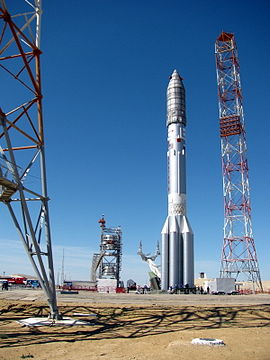Proton-M

Proton-M rocket on the launchpad
|
|
| Function | Heavy-lift launch vehicle |
|---|---|
| Manufacturer | Khrunichev |
| Country of origin | Russia |
| Size | |
| Height | 58.2 m (191 ft) |
| Diameter | 7.4 m (24 ft) |
| Mass | 705,000 kg (1,554,000 lb) |
| Stages | 3 or 4 |
| Capacity | |
| Payload to LEO | 23,000 kg (51,000 lb) |
| Payload to GTO 1800 m/s | 6,920 kg (15,260 lb) |
| Payload to GTO 1500 m/s | 6,300 kg (13,900 lb) |
| Payload to GSO | 3,250 kg (7,170 lb) |
| Associated rockets | |
| Family | Universal Rocket |
| Launch history | |
| Status | Active |
| Launch sites | |
| Total launches | 98 |
| Successes | 88 |
| Failures | 9 |
| Partial failures | 1 |
| First flight | 7 April 2001 |
| Last flight | 9 June 2016 |
| First stage - 8S810K | |
| Length | 21.18 m (69.5 ft) |
| Diameter | 7.4 m (24 ft) |
| Empty mass | 30,600 kg (67,500 lb) |
| Propellant mass | 428,300 kg (944,200 lb) |
| Engines | 6 RD-275M |
| Thrust | 10,532 kN (2,368,000 lbf) |
| Specific impulse | 285 sec |
| Burn time | 108 sec |
| Fuel | N2O4 / UDMH |
| Second stage - 8S811K | |
| Length | 17.05 m (55.9 ft) |
| Diameter | 4.1 m (13 ft) |
| Empty mass | 11,000 kg (24,000 lb) |
| Propellant mass | 157,300 kg (346,800 lb) |
| Engines | 3 RD-0210 1 RD-0211 |
| Thrust | 2,399 kN (539,000 lbf) |
| Specific impulse | 327 sec |
| Burn time | 206 sec |
| Fuel | N2O4 / UDMH |
| Third stage - 8S812 | |
| Length | 4.11 m (13.5 ft) |
| Diameter | 4.1 m (13 ft) |
| Empty mass | 3,500 kg (7,700 lb) |
| Propellant mass | 46,562 kg (102,652 lb) |
| Engines | 1 RD-0212 |
| Thrust | 613.8 kN (138,000 lbf) |
| Specific impulse | 325 sec |
| Burn time | 238 sec |
| Fuel | N2O4 / UDMH |
| Fourth stage (optional) - Briz-M | |
| Length | 2.61 m (8 ft 7 in) |
| Diameter | 4.0 m (13.1 ft) |
| Empty mass | 2,370 kg (5,220 lb) |
| Propellant mass | 19,800 kg (43,700 lb) |
| Engines | 1 S5.98M |
| Thrust | 19.62 kN (4,410 lbf) |
| Specific impulse | 326 sec |
| Burn time | 3000 sec |
| Fuel | N2O4 / UDMH |
| Fourth stage (optional) - Blok DM-2 | |
| Engines | 1 RD-58M |
| Thrust | 85 kN (19,000 lbf) |
| Specific impulse | 352 sec |
| Fuel | RP-1 / LOX |
| Fourth stage (optional) - Blok DM-03 | |
| Engines | 1 RD-58M/RD-58MF |
| Fuel | RP-1 / LOX |
The Proton-M, (Протон-М) GRAU index 8K82M or 8K82KM, is a Russian heavy-lift launch vehicle derived from the Soviet-developed Proton. It is built by Khrunichev, and launched from sites 81 and 200 at the Baikonur Cosmodrome in Kazakhstan. Commercial launches are marketed by International Launch Services (ILS), and generally use Site 200/39. The first Proton-M launch occurred on 7 April 2001.
The Proton-M launch vehicle consists of 3 stages; all of them powered by liquid rocket engines using the hypergolic propellant combination of dinitrogen tetroxide as the oxidizer, and unsymmetrical dimethylhydrazine for fuel (see infobox).
The first stage is unique in that it consists of a central cylindrical oxidizer tank with the same diameter as the other 2 stages with 6 fuel tanks attached to its circumference, each carrying an engine. The engines in this stage can swivel tangentially up to 7° from the neutral position, providing full thrust vector control. The rationale for this design is logistics: the diameter of the oxidizer tanks and the 2 following stages is the maximum that can be delivered by railroad to Baikonur. However, within Baikonur the fully assembled stack is transported again by rail, as it has enough clearance.
The second stage uses a conventional cylindrical design. It is powered by 3 RD-0210 engine and 1 RD-0211 engine. The RD-0211 is a modified version of the RD-0210 used to pressurize the propellant tanks. The second stage is joined to the first stage through a net instead of a closed inter-stage, to allow the exhaust to escape because the second stage begins firing seconds before separation. Thrust vector control is provided by engine gimballing.
...
Wikipedia
